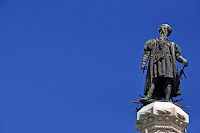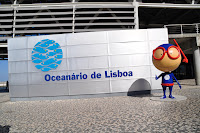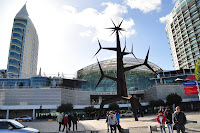Our original plan was to visit the Mosteiro da Batalha in of course Batalha, the ancient castle and walls in Obidos, then also to Mafra National Palace and to the Alcobaça monastery, the Moistero de Nazare. All of which are world heritage sites. The only problem was the distance, and it would already be tiring to go visit all these places at once. Going to Batalha alone would take two hours with a bus from Lisbon. Obidos from Sintra would have been closer. All directions go via Lisbon, and in the end, it would be too much for me. Besides, I've seen enough of churches, castles and the likes, so I needed a change of scenery. It was decided that we would go to Lisbon. The original plan was to go to Lisbon from Cascais during our last days in Portugal.
It was decided to go to Lisbon then since it's only an hour ride by train from Sintra. We got off at Rossio station which located very central in Lisbon. The city has several great places right around there, and everything about seemed historically important and impressive, even the Starbucks. Even Lisbon looks clean for a big city. We were asked on a small street by a shady character if we want cocaine or some other drugs. I wanted breakfast and not cocaine (lol), but unfortunately, the guy didn't sell us a meal.
So we went further to another small street, but seems like everything around this area was kind of pricey. We finally found a little bakery with stand-up counter with a lot of people having breakfast. But to my friend's horror, his Schmalzkuchen (some kind of doughnut) was filled with shrimps. He's kind of picky about food and not the type you wanted to take with you to eat out. But it did make me happy because I love seafood. But there were plenty of other goodies, so he didn't go hungry.
When we went out, it suddenly rained, and we first had to go find a place to hide. We almost bought an umbrella from a woman who happened to be selling them but noticed how unstable it looked in the wind and probably would just have lasted for half an hour or so. We waited a little bit until the rain let up a little and then walked and came upon a tram-stop which happen to have a tram coming in, rode that tram on the way to Belém. The tram was overfilled, but we are lucky to have a standing place next to a broken door because it remained closed at all stops and no jostling crowd coming through us. But it seemed like everyone wanted to go to Belém. The tram was held up at a station near the Mosteiro dos Jerónimos and stayed there for a while. There was an announcement in Portuguese, but it seemed that no one really quite understood what was going on. Some people went out, then got in again, then out and in again. Most of the people stayed in, but we wanted to make use of the little time that we had so proceeded on foot. I'm glad we did, or else we wouldn't have discovered a beautiful square, the Praça Afonso de Albuquerque which was located in front of the Belém Palace.
On the way to St. Jerome's Monastery, we passed by a parade with soldiers on horses. We didn't really know what was going on. There was a long queue at the entrance of the monastery, and both of us have no desire to wait for like forever to get in. It looks awe-inspiring even just from outside. Maybe I will go in next time I'm in Lisbon. The Mosteiro dos Jerónimos together with the tower of Belém were inscribed to the UNESCO's World Heritage List. On the west wing of the monastery is the Museu de Marinha, where we went instead. It was even free on a Sunday. It showcases the maritime history of Portugal as well as the many first world navigators. The collection was pretty impressive, and I was awed at the fact that many of the things we know today about the world were based on such exploration of this nation. It was widely believed that the world was flat during those times. It is indeed interesting to note how Portugal changed the world.
Directly opposite is the vast Centro Cultural de Belém, but we wanted to go straight to the Torre de Belém. This fortified tower (also known as Tower of St. Vincent) also played an important role during the Age of Discoveries. The entrance is free on Sunday. It was mainly surrounded by water, the Tagus river and accessible through a very short bridge. There was even a lot going on but fortunately no massive queues like at the monastery. The Moorish influence in the architecture, the decorative carvings and the domed watchtower is quite apparent. We just went on the platform and down in the cellar. I have learned that the tower was used mainly as a prison, then as a customs house. There was the throng of people going up to the watchtower, so we decided not to go up anymore. I have seen the next monument and a modern architecture on the right side of the tower, so we went out and went to see those. We just passed by the "Colonial Wars Monument". The two triangular shaped structure with a flame in between commemorates those who fought in all colonial wars fought by the Portuguese soldiers overseas including Brazil, Goa, Macao, Angola, Mozambique etc. But I was more interested in the impressive modern architecture next to it, the Champalimaud Center for the Unknown.
From there we walked back to the huge monument, the "Padrão dos Descobrimentos" (lit. Monument to Discoveries) with the view directed towards the river and the sky. It's located across the Jeronimos cloister at the northern margin of the Tagus river. One can go up the towering monument, but we weren't motivated enough to do so. The plaster on my blistered feet gave way, and there was no bus in sight. We didn't have much time, and if we wanted to make the most of our day in Lisbon, we had to keep moving.
From there, we took a taxi (costs around 10€) to the "Oceanário". It is located on the other side of the city at the Parque das Nações, which was the exhibition grounds of Expo 98. It was good that we took a taxi since we passed by the next bus stop which was way too far from our point of origin. We arrived at the Oceanário and found several lovely looking modern architecture around.
The Oceanário de Lisboa, said to be the second largest aquarium in the world, was well worth seeing. Its main attraction is the large tank, also called the "global ocean" with glass walls that can be viewed from different levels. There are also the smaller tanks of North Atlantic, Antarctic, temperate Pacific and tropical Indian. Several species are to be seen as stingrays, sharks, fishes as well as colourful corals and avian species. The complete list is on their website. We probably spent a good couple of hours just watching different marine life.
So we went further to another small street, but seems like everything around this area was kind of pricey. We finally found a little bakery with stand-up counter with a lot of people having breakfast. But to my friend's horror, his Schmalzkuchen (some kind of doughnut) was filled with shrimps. He's kind of picky about food and not the type you wanted to take with you to eat out. But it did make me happy because I love seafood. But there were plenty of other goodies, so he didn't go hungry.
When we went out, it suddenly rained, and we first had to go find a place to hide. We almost bought an umbrella from a woman who happened to be selling them but noticed how unstable it looked in the wind and probably would just have lasted for half an hour or so. We waited a little bit until the rain let up a little and then walked and came upon a tram-stop which happen to have a tram coming in, rode that tram on the way to Belém. The tram was overfilled, but we are lucky to have a standing place next to a broken door because it remained closed at all stops and no jostling crowd coming through us. But it seemed like everyone wanted to go to Belém. The tram was held up at a station near the Mosteiro dos Jerónimos and stayed there for a while. There was an announcement in Portuguese, but it seemed that no one really quite understood what was going on. Some people went out, then got in again, then out and in again. Most of the people stayed in, but we wanted to make use of the little time that we had so proceeded on foot. I'm glad we did, or else we wouldn't have discovered a beautiful square, the Praça Afonso de Albuquerque which was located in front of the Belém Palace.
On the way to St. Jerome's Monastery, we passed by a parade with soldiers on horses. We didn't really know what was going on. There was a long queue at the entrance of the monastery, and both of us have no desire to wait for like forever to get in. It looks awe-inspiring even just from outside. Maybe I will go in next time I'm in Lisbon. The Mosteiro dos Jerónimos together with the tower of Belém were inscribed to the UNESCO's World Heritage List. On the west wing of the monastery is the Museu de Marinha, where we went instead. It was even free on a Sunday. It showcases the maritime history of Portugal as well as the many first world navigators. The collection was pretty impressive, and I was awed at the fact that many of the things we know today about the world were based on such exploration of this nation. It was widely believed that the world was flat during those times. It is indeed interesting to note how Portugal changed the world.
Directly opposite is the vast Centro Cultural de Belém, but we wanted to go straight to the Torre de Belém. This fortified tower (also known as Tower of St. Vincent) also played an important role during the Age of Discoveries. The entrance is free on Sunday. It was mainly surrounded by water, the Tagus river and accessible through a very short bridge. There was even a lot going on but fortunately no massive queues like at the monastery. The Moorish influence in the architecture, the decorative carvings and the domed watchtower is quite apparent. We just went on the platform and down in the cellar. I have learned that the tower was used mainly as a prison, then as a customs house. There was the throng of people going up to the watchtower, so we decided not to go up anymore. I have seen the next monument and a modern architecture on the right side of the tower, so we went out and went to see those. We just passed by the "Colonial Wars Monument". The two triangular shaped structure with a flame in between commemorates those who fought in all colonial wars fought by the Portuguese soldiers overseas including Brazil, Goa, Macao, Angola, Mozambique etc. But I was more interested in the impressive modern architecture next to it, the Champalimaud Center for the Unknown.
From there we walked back to the huge monument, the "Padrão dos Descobrimentos" (lit. Monument to Discoveries) with the view directed towards the river and the sky. It's located across the Jeronimos cloister at the northern margin of the Tagus river. One can go up the towering monument, but we weren't motivated enough to do so. The plaster on my blistered feet gave way, and there was no bus in sight. We didn't have much time, and if we wanted to make the most of our day in Lisbon, we had to keep moving.
From there, we took a taxi (costs around 10€) to the "Oceanário". It is located on the other side of the city at the Parque das Nações, which was the exhibition grounds of Expo 98. It was good that we took a taxi since we passed by the next bus stop which was way too far from our point of origin. We arrived at the Oceanário and found several lovely looking modern architecture around.
The Oceanário de Lisboa, said to be the second largest aquarium in the world, was well worth seeing. Its main attraction is the large tank, also called the "global ocean" with glass walls that can be viewed from different levels. There are also the smaller tanks of North Atlantic, Antarctic, temperate Pacific and tropical Indian. Several species are to be seen as stingrays, sharks, fishes as well as colourful corals and avian species. The complete list is on their website. We probably spent a good couple of hours just watching different marine life.
We've seen the cable car next to the oceanarium and wanted to ride it, but it was too windy, and they closed it. It should have offered a fantastic view of the Park of Nations, the Vasco da Gama Bridge crossing the 11 kilometres width of Tagus River. Then we walked through the Expo park and through the Centro Vasco da Gama (shopping mall) and into the architectural gem of Gare do Oriente. This railway station is an attraction itself. It was designed by the Spanish architect, Santiago Calatrava.
We then took the subway back to Rossio station where we took another train going back to Sintra. After a somewhat disappointing pizza the previous night, we thought it better to go again to the next door Chinese restaurant. This time, my companion got a fried ice cream for dessert. You've read it right, it's fried ice cream.




































































This is like reading a travel guide! Have you ever seen those travel programs on 3Sat? Well, there is a similarity except that yours is a blog while the other is on tape/camera. =)
ReplyDeleteAnyway, Portugal is a lovely place and full of history. The Portuguese are quite friendly people too. And you posted cool photos.